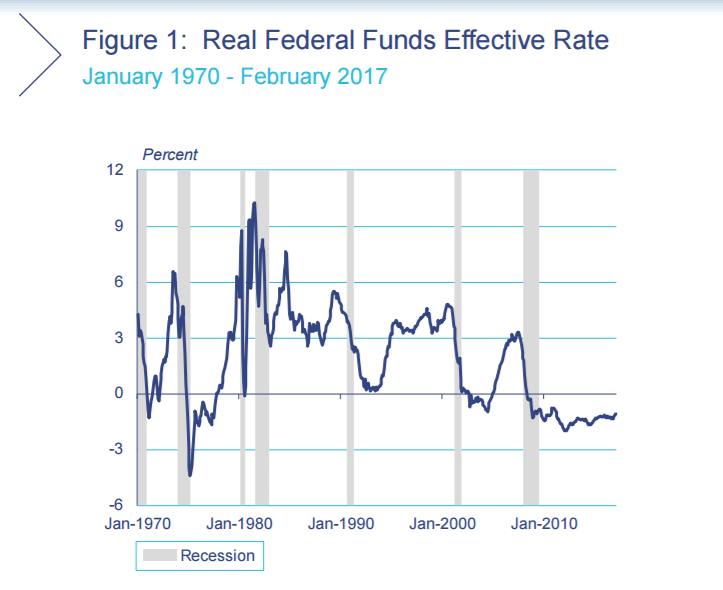Academic bloggers and other high-profile commentators have argued there is still sufficient slack in the economy to warrant keeping rates low for now. Labor utilization measures (such as the U-6 unemployment rate) and wages are still weak. Top-line economic growth is still modest or moderate (to use two of the Fed’s favorite adjectives). And normalizing energy costs are the primary reason inflation is increasing. As of now, there are no indications that commodity price increases are seeping into broader price measures.
But this week, Fed President’s Rosengren and Williams explained the Fed’s primary justification for raising rates. An analysis combining elements of both speeches clearly outlines the Fed’s rationalization.
Both governors believe the economy has achieved the Fed’s dual mandate of low unemployment growth. Here is Williams’ description:
With the attainment of our dual mandate goals close at hand, now is more important than ever for monetary policy to work toward what I like to call a “Goldilocks economy” – an economy that doesn’t run too hot or too cold. We want the porridge to be just right.
Our aim is to keep the economic expansion on a sound footing that can be sustained for as long as possible. The last thing any of us want is to undermine the hard-won gains we’ve made since the dark days of the recession.2
Rosengren phrases it slightly differently, but the same meaning is clear:
At present, the perception seems to be that the outcome of each FOMC meeting depends on nuances of incoming data, with the base case being no change in rates. I would like to suggest a somewhat different stance for policy over this year: an expectation to tighten at every other meeting unless incoming data are materially inconsistent with the forecast. Importantly, this would still be a fully data-dependent approach, not a preset path, as it would hinge on the incoming data – but the base case would be four tightenings, reflecting the strength of the economy that I believe justifies more regular normalization of interest rates.
Such a gradual, but more regular, tightening of rates is consistent with both the improved “starting” conditions and the continued good news about the economy. As I will describe today, it seems likely that the economy will have achieved both elements of the Federal Reserve’s dual mandate by the end of this year – full employment and stable prices (which the Federal Reserve defines as 2 percent inflation). Even as the economy approaches the Fed’s dual mandate goals, we still have a federal funds rate that is less than 1 percent, while inflation is approaching percent, which implies a negative real interest rate (simply because the inflation rate exceeds the nominal interest rate). While it is not unusual to have negative real interest rates when the economy is quite weak, as I will show today, it is unusual to still have negative real interest rates late in a recovery when the economy is close to full employment and nearing the inflation target.
Shorter Williams and Rosengren: the U.S. economy has achieved maximum employment and price stability. Williams then argues that, because the economy has reached the Fed’s goals, the Fed needs to do everything it can to increase the expansion’s duration and, just as importantly, keep the economy from overheating:
As it stands today, with the economy in striking distance of our goals, monetary policy still has the pedal to the metal. Even with the rate increase the FOMC announced a couple weeks ago at its March meeting, interest rates remain near historical lows. I’m sure that many, if not most of you, have taken a look at the FOMC’s statement which noted that “the federal funds rate is likely to remain, for some time, below levels that are expected to prevail in the longer run.”3
I’m often asked, “since things are going well, why not just keep our foot on the gas?” The answer is that lifting it gradually off the pedal prevents the economy from overheating.
This is why the FOMC took action in March, and why the median view of my FOMC colleagues is for three interest rate increases in 2017.4 My own view is similar to most of my FOMC colleagues. I should note, however, that given my forecast, along with upside risks, I would not rule out more than three increases total for this year.
I want to emphasize that I see the pace of rate increases as gradual – that is, slower than in past economic expansions – and intended to bring monetary policy back to a normal stance.
Importantly, I am confident that the economy will continue to grow at a healthy pace as we pursue this path of normalization.
Rosengren has a slightly different justification: the economy is in unchartered territory – the expansion is in its 8th year yet the federal funds rate is negative. Rosengren’s argument is that the Fed is already behind when it comes to interest rates and therefore needs to play catch-up. He relies on several indicators to support his argument, starting with the relationship of interest rates to the duration of the expansion:


The top chart shows the length of negative interest rates relative to the end of the preceding recession. During the current expansion, negative rates have lasted for far longer than in previous expansions. The second charts observes that in previous expansion, the unemployment rate was far higher when the Fed started to raise interest rates. Both of these charts seem to indicate that Rosengren is relying on time as the primary reason why the Fed should increase interest rates, especially relative to the current low unemployment rate. In addition to the long period of negative rates, Rosengren observes that future predictions of economic activity are bullish, implying that, if the Fed doesn’t raise rates, then the economy will overheat forcing the Fed to eventually raise rates at a far faster pace. This would probably stave off growth leading to a recession.
